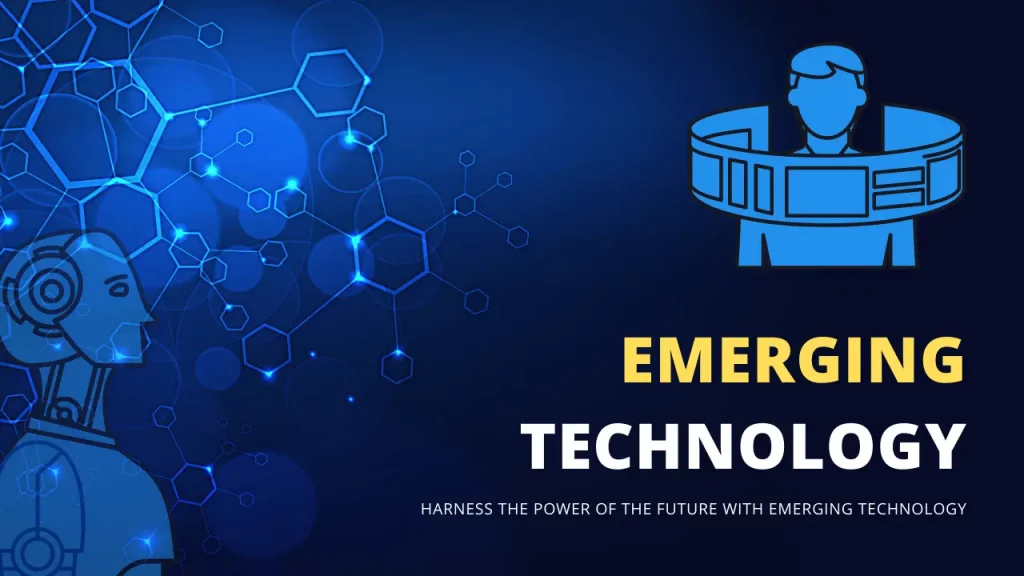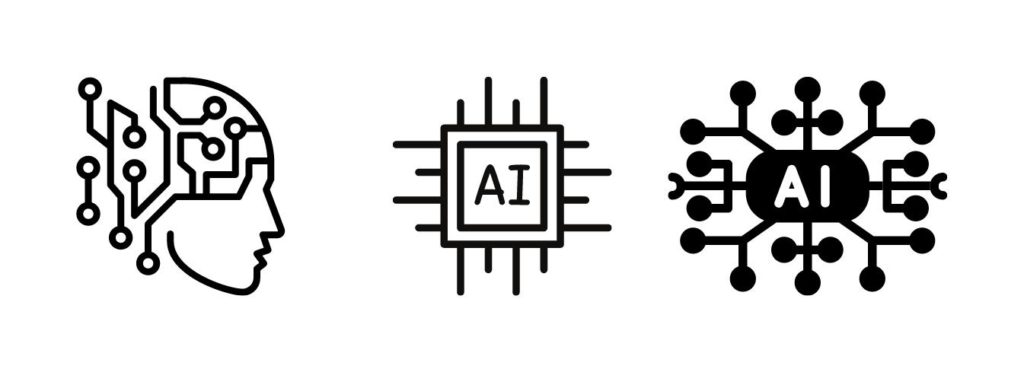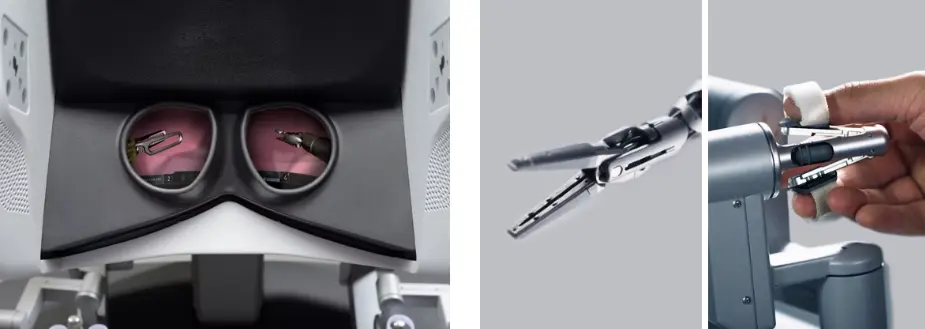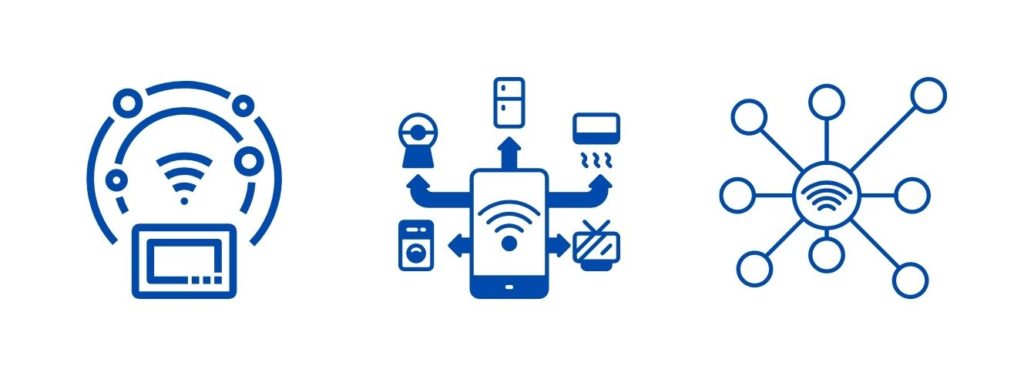In a world that is quickly advancing in technology, it can sometimes be difficult to keep up with all of the emerging technologies. From Artificial Intelligence (AI), Automation, and Robotics, to 5G networks and biometrics, there is a multitude of new technological advances which are being developed each day. To ensure you stay up to date on the latest trends, here is an overview of some of the most popular types of emerging technologies:

Table of Contents
Artificial Intelligence
AI refers to machines that can think, reason, and make decisions like humans do.
Artificial Intelligence (AI) has quickly become an integral and increasingly pervasive part of our lives. AI can simulate the cognitive functions of human beings in various ways and applications, such as facial recognition systems, virtual assistants like Alexa and Siri, autonomous vehicles, and much more.
To fuel this technology, AI utilizes various components such as machine learning algorithms, deep learning architectures, and natural language processing. Aside from its industrial use cases, AI is also used in a number of fields including marketing, finance, healthcare, and education. AI’s potential is practically limitless – it can be utilized by virtually every industry for its own specific needs.

With this powerful tool in their arsenal, businesses can take advantage of data-driven insights in order to be better informed about their strategies.
Additionally, the use of AI can help organizations improve customer service experiences through chatbots that are capable of comprehensive dialogue with customers.
As technological advancements continue to shape our world as we know it today, Artificial Intelligence is sure to remain a cornerstone for years to come.
Automation
Automation is the process of using software or machines to automate repetitive tasks or processes. It has become increasingly popular due to its ability to drastically increase efficiency and reduce costs.
As businesses strive to stay competitive, they are often overwhelmed by the sheer amount of manual labor and tedious tasks that need to be done. Not only is this time-consuming, but it can also lead to costly errors due to human error. Additionally, these mundane tasks can take away from more important activities such as innovation and customer service.
Automation provides a solution for businesses looking for an efficient way to manage their operations without sacrificing quality or accuracy. Automation allows companies to automate repetitive processes in order to save time and money while freeing up resources for more strategic endeavors.
By utilizing automation tools like robotic process automation (RPA) and machine learning algorithms, organizations can streamline their operations while boosting productivity and efficiency levels across the board. With automation, businesses can reduce costs associated with manual labor while increasing output at a faster rate than ever before – all without compromising on quality!
Robotics
Robotics is the study and use of robots for various industrial or manufacturing tasks that may have been previously completed by humans. Robot arms are commonly used for assembly line production as well as medical surgeries.
Robots are typically used for tasks that are repetitive, dangerous or require a high level of precision. They are commonly used in industries such as manufacturing, construction, agriculture, and healthcare.
An example of a robot being used in manufacturing is a robot arm that is programmed to assemble car parts on an assembly line. The robot arm is able to perform the task with a high level of precision and speed, making the production process more efficient.

In healthcare, robots are sometimes used for surgery. For example, a robot called the Da Vinci surgical system is used for minimally invasive surgery. It allows surgeons to perform complex procedures using small incisions, which can reduce the risk of complications and improve patient outcomes.
Robots are also used in a variety of other industries, such as agriculture, where they can be used for tasks such as planting and harvesting crops, and in construction, where they can be used for tasks such as laying bricks or welding.
3-D Printing
3D printing, also known as additive manufacturing, is a process in which a physical object is created by building up layers of material based on a digital model. The digital model is created using computer-aided design (CAD) software and is then used to guide the 3D printer as it creates the physical object.
3D printing has a wide range of applications and has the potential to revolutionize the way that products are designed and manufactured. For example, it can be used to create prototypes of products, allowing designers and engineers to test and refine their designs before going into mass production. It can also be used to create custom products or parts, such as medical implants or prosthetics, that are tailored to the specific needs of an individual.
In the field of healthcare, 3D printing has been used to create a variety of medical implants, such as prosthetics and replacement joints. It has also been used to create custom hearing aids, dental implants, and even entire prosthetic hands.
3D printing has the potential to greatly reduce the time and cost associated with traditional manufacturing methods, making it easier and more affordable to create custom products and parts. It also allows for more efficient use of materials, as only the material that is needed for the specific product is used, reducing waste.
5G
5G is the fifth generation of cellular network technology and is designed to offer faster data speeds and lower latency than previous generations of mobile networks. It is expected to provide a significant increase in the speed and capacity of wireless communication systems, which will enable a wide range of new applications and services.
One of the main benefits of 5G is that it will allow for much faster data speeds, which will enable users to access high-bandwidth applications and services such as streaming video, online gaming, and virtual reality. For example, with 5G, users will be able to stream high-definition videos and play online games with minimal latency, making for a much more seamless and enjoyable experience.
In addition to faster data speeds, 5G is also expected to offer lower latency, which means that the time it takes for data to be transmitted from one device to another will be significantly reduced. This will be especially useful for applications that require real-time communication, such as remote surgery or self-driving cars.
iOT
The Internet of Things (IoT) refers to devices that are connected to the internet and able to collect information and send data back out on their own without any human input or control.
These devices, which can include everything from smart home appliances to industrial equipment to wearable technology, are able to collect, transmit, and analyze data in order to improve efficiency, convenience, and security.

One example of an IoT device is a smart thermostat, which is connected to the internet and can be controlled remotely using a smartphone app. The smart thermostat is able to learn the user’s preferred temperature settings and can automatically adjust the temperature in the home based on the user’s schedule and the weather outside. It can also track energy usage and provide the user with reports and recommendations for saving energy.
Other examples of IoT devices include smart security cameras, smart appliances such as washing machines and refrigerators, and wearable fitness trackers. These devices are able to collect and transmit data about their usage and performance, allowing for more efficient operation and improved user experience.
Serverless Computing
Serverless computing is a cloud computing model in which the cloud provider dynamically allocates and scales computing resources in response to incoming requests, rather than requiring users to allocate and manage dedicated servers or virtual machines. This means that users can access cloud services on an as-needed basis, without having to worry about setting up and maintaining physical infrastructure.
An example of serverless computing might be a company that provides a mobile app for booking hotel rooms. This app might use serverless computing to allow users to search for available rooms and make reservations. The cloud provider would allocate the necessary computing resources to handle the incoming requests and perform the required tasks, such as searching for available rooms and updating the reservation database. The company would only pay for the specific resources that were used during each request, rather than having to pay for dedicated servers or virtual machines to handle the workload.
Serverless computing can provide many benefits, including lower costs, improved scalability, and greater flexibility. It can be particularly useful for companies that have highly variable or unpredictable workloads, as it allows them to access the resources they need on an as-needed basis.
Quantum Computing
Quantum computing is a rapidly evolving field that uses principles from quantum mechanics to perform calculations much faster than traditional computers. Quantum computers use quantum bits, or qubits, which can exist in multiple states simultaneously, to represent and manipulate data. This allows them to perform certain types of calculations much more efficiently than classical computers, which use bits that can only exist in a single state at a time.
One potential application of quantum computing is in the field of cybersecurity. Quantum computers can potentially be used to break certain types of encryption that are currently considered secure, such as the encryption used to protect online financial transactions. This makes them a potential threat to the security of sensitive information, and also a potential tool for protecting that information.
Another potential application of quantum computing is in healthcare. Quantum computers could be used to analyze large datasets, such as genetic data or medical records, much more quickly and accurately than classical computers. This could potentially lead to the development of more effective treatments for diseases and the design of personalized medical therapies.
There are many other potential applications for quantum computing, including financial modeling, weather forecasting, and material science. While quantum computers are still in the early stages of development and there are many technical challenges that need to be overcome, they hold great promise for a wide range of fields.
Biometrics
Biometric identification is a method of verifying an individual’s identity using their unique physical characteristics. This can include features such as facial recognition, fingerprints, retina scans, and voice recognition, among others. Biometric systems use algorithms to compare the physical characteristics of an individual to a stored reference, and can be used to confirm or deny access to a particular location or system.
One example of biometric identification is the use of fingerprint scanners to unlock smartphones. When a user touches the scanner, the phone compares the fingerprint to a reference stored in its database and unlocks if the two match. Another example is the use of facial recognition technology to grant access to secure locations, such as airports or government buildings. In this case, a camera captures an image of the individual’s face and compares it to a reference stored in a database. If the images match, the system grants access.
Biometric identification systems are becoming increasingly popular due to their ability to provide secure access to sensitive locations or systems. They can be more reliable and less prone to errors than traditional methods such as passwords or PIN codes, which can be forgotten or stolen. However, biometric systems also raise concerns about privacy and the potential for abuse, as they rely on the collection and storage of personal information.
VR/AR
Virtual reality (VR) and augmented reality (AR) are two emerging technologies that are being used in a variety of industries.
Virtual reality involves the use of computer simulations to replicate real-life settings, allowing users to interact with virtual environments as if they were physically present. VR can be experienced through the use of specialized headsets or other hardware, such as haptic feedback devices, which provide a sense of touch. VR is often used for entertainment purposes, such as in video games, but it also has applications in fields such as education, military training, and healthcare.
Augmented reality involves the overlay of virtual elements onto the real world, typically through the use of a smartphone or other device. AR can be experienced through the use of mobile apps or platforms, such as Snapchat filters, which add virtual elements to the user’s view of the real world. AR has a variety of applications, including in gaming, retail, and advertising.
One example of the use of VR is in the gaming industry, where players can use VR headsets to immerse themselves in virtual environments and interact with virtual objects as if they were physically present. In the field of education, VR can be used to create interactive learning experiences, allowing students to explore virtual environments and participate in simulations. In the military, VR can be used to train soldiers in simulated combat scenarios, allowing them to practice skills and tactics in a safe and controlled environment.
AR has also been used in a variety of industries, such as in retail, where it can be used to create interactive shopping experiences by overlaying virtual elements onto real-world products. In advertising, AR can be used to create interactive marketing campaigns, allowing users to interact with virtual elements in their environment.
Natural Language Processing
Natural language processing (NLP) is a field of artificial intelligence that focuses on enabling computers to understand and interpret human language in a natural way. It uses techniques such as machine learning algorithms to analyze and interpret the structure and meaning of human language, without requiring predefined rules.
NLP has revolutionized how computers interact with humans, enabling tasks such as automated customer service reps and voice-activated assistants. These systems can understand and respond to natural language inputs, allowing humans to communicate with computers in a more natural and intuitive way.
One example of NLP is the use of voice-activated assistants, such as Apple’s Siri or Amazon’s Alexa. These assistants use NLP to understand and interpret the words and phrases spoken by users and can perform tasks such as setting alarms, answering questions, and playing music. Another example is the use of NLP in customer service, where it can be used to enable automated chatbots or virtual assistants to understand and respond to customer inquiries in a natural way.
NLP has a wide range of applications, including in natural language generation, machine translation, and text classification. It has the potential to greatly improve the way humans interact with computers and can enable the development of more intuitive and user-friendly systems.
Nanotechnology
Nanotechnology is the study and application of extremely small things, on the scale of atoms and molecules. It involves the use of materials, devices, and systems that have dimensions in the nanoscale range, which is typically defined as being between 1 and 100 nanometers (1 nanometer is equal to one billionth of a meter).
One example of nanotechnology is the use of nanoparticles to deliver drugs directly to cancer cells, as you mentioned. In this case, the nanoparticles are designed to target specific cells, such as cancer cells, and deliver a payload of drugs directly to those cells. This can help to reduce the side effects of chemotherapy, as the drugs are more targeted and do not affect healthy cells in the same way.
Other examples of nanotechnology include the use of nanomaterials in solar cells to improve their efficiency, the development of nanoscale sensors for use in medical diagnostics, and the use of nanostructured surfaces to improve the performance of batteries and other energy storage devices.
Nanotechnology has the potential to revolutionize a wide range of fields, including medicine, energy, electronics, and materials science. It offers the promise of developing new and improved materials and devices with novel properties and functions.
The Future?
It is difficult to make precise predictions about future technology, as it is constantly evolving and there are many factors that can influence its development. However, there are a few trends and areas of research that are likely to continue to shape the direction of technology in the coming years.
One trend that is likely to continue is the increasing use of artificial intelligence (AI) and machine learning in a variety of applications. AI has the potential to transform many industries, from healthcare and finance to transportation and manufacturing. It can be used to analyze and interpret large amounts of data, automate tasks, and make predictions and recommendations.
Another trend is the growing use of the internet of things (IoT), which involves the integration of sensors and other devices into everyday objects to enable them to connect and communicate with each other. The IoT has the potential to improve efficiency and convenience in a wide range of industries, such as healthcare, transportation, and energy.
Other areas of research that are likely to continue to shape the direction of future technology include quantum computing, which has the potential to perform certain types of calculations much faster than traditional computers; biotechnology, which involves the use of living organisms or their components to create new materials and products; and renewable energy technologies, which are becoming increasingly important as the world looks for ways to reduce its reliance on fossil fuels.


